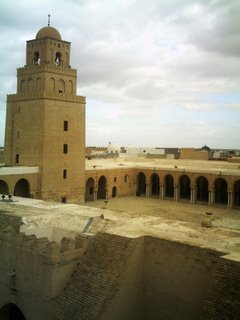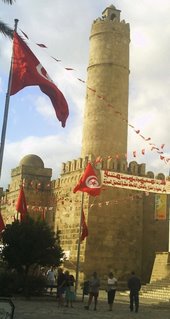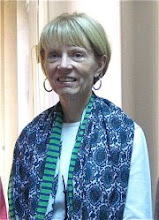History and Tourist Traps

Kairouan
Kairouan is inland on an arid Tunisian plain. However, it’s significance is twofold: 1) It signifies the planting of Islam in Tunisia, then part of Ifriqiyya. The Muslim Arab commander, Uqba Ibn Nafi, chose the location for his capital in 670 AD and constructed the Great Mosque. It has 400 columns, garnered from nearby Roman ruins. The rounded, vertical filaments marking the dome of the minaret, added by the Aghlabids, is a stylistic innovation, symbol of the creativity and productivity under the dynasty. Thus, Kairouan is considered the fourth most important Islamic city after Mecca, Medina, and Jerusalem. Little tourism is visible in the city itself as Kairouan remains true to its spiritual calling. Thus, I saw some traditional craftsmen at work. However, examples of their wares, as well as the city’s fame for carpet making, seem in decline. I did see shops selling camel meat, with legs and other parts suspended in front. The most astonishing were those in which a Holstein cow’s head looks out from the middle of a frame out-front a sort of customary logo). I also saw the Mausoleum (or zawiya) of Sidi Sahab el Balaoui, the Barber. He was a companion of the Prophet Muhammad and carried three hairs from his beard with him at all times, hence the name. Ceramic tiles from Nabeul in numerous designs the entry. 2) After much Berber resistance, the Aghlabid Dynasty established its rule (800-909), and secured the Maliki school of Islam (more moderate) as the most important in Tunisia and, eventually, North Africa. The Aghlabids conquered Sicily and reaffirmed Kairouan’s position as a great center of Islamic culture. On the way into Kairouan I saw two large polygonal-style basins (water reservoirs) built by the Aghlabids. Supplied by mountain water via an aqueduct, the first served as a receptacle for the more plentiful second. The temperature can reach 47˚C in summer.
I also saw the Mausoleum (or zawiya) of Sidi Sahab el Balaoui, the Barber. He was a companion of the Prophet Muhammad and carried three hairs from his beard with him at all times, hence the name. Ceramic tiles from Nabeul in numerous designs the entry. 2) After much Berber resistance, the Aghlabid Dynasty established its rule (800-909), and secured the Maliki school of Islam (more moderate) as the most important in Tunisia and, eventually, North Africa. The Aghlabids conquered Sicily and reaffirmed Kairouan’s position as a great center of Islamic culture. On the way into Kairouan I saw two large polygonal-style basins (water reservoirs) built by the Aghlabids. Supplied by mountain water via an aqueduct, the first served as a receptacle for the more plentiful second. The temperature can reach 47˚C in summer.
There are three factories in Kairouan but unemployment is high (40% among males). Women can find some work through domestic labor and carpet weaving, which can be done at home.
Sousse
Tourists: the Tunisian Economic Mainstay
 Sousse is the largest tourist center in Tunisia, according to the guide. Many, many hotels line the corniche, which prospective bathers have to cross to access the beach. Closer to the medina, a Shopping Center (large store) for Tourists is available. Replicas of pirate ships obtrude from the waterfront. Too touristy for me. Bright white villas with turquoise mashroubiyya (turned wood, grilled screens) windows doors can be a pleasant diversion. However, my taxi driver (guide) said the place is swarming with tourists during the summer; and some are there even now. Most are German, French, and British. The medina appears cleaned up for tourists, with fewer of the traditional crafts of exceptional quality left.
Sousse is the largest tourist center in Tunisia, according to the guide. Many, many hotels line the corniche, which prospective bathers have to cross to access the beach. Closer to the medina, a Shopping Center (large store) for Tourists is available. Replicas of pirate ships obtrude from the waterfront. Too touristy for me. Bright white villas with turquoise mashroubiyya (turned wood, grilled screens) windows doors can be a pleasant diversion. However, my taxi driver (guide) said the place is swarming with tourists during the summer; and some are there even now. Most are German, French, and British. The medina appears cleaned up for tourists, with fewer of the traditional crafts of exceptional quality left.
Historical Inheritance
Founded in the 9th century before Christ by the Phoenicians, few footprints remain of ancient settlers (Greek, Punic, Roman). I found the thick defensive walls (constructed in 859 AD), Great Mosque, and ribat (combination monastery and fortress) the most fascinating. An Abbasid emir constructed the Great Mosque in 850 AD. The Abbasids succeeded the Umayyads, whose reign came to an end in 750 AD. The ribat dates from the 8th century. Conceived for military purposes, it also provided ideological motivation through religious instruction and devotion. The fortress would protect the local populace, when it came under siege. Simultaneously, it provided shelter to marabouts (holy men, teachers of and experts on the Qur’an, occasionally warriors, known for their baraka (power of blessing) and performance of miracles), who provided spiritual solace and instruction to followers who lived at the nearby mosque and to the population in general. The architecture of these structures is simple, somber, and austere, typical of early mosques.
Commercialized Wisconsin Dells à la Tunisien
 Port El Kantaoui is a tourist trap. Developed only in 1978, it is entirely devoted to tourism and their entertainment. I noticed the Hotel Hannibal, Kangaroo disco, bumper car rides for children on the way in. For a Mid-Westerner, it’s a bit like the commercialized part of Wisconsin Dells in Tunisia. Hotel, apartment, and shopping complexes, plus restaurants, built solely to cater to the tourist trade. Gardens of blooming fuchsias, bougainvilleas, jasmines roses surround the marina, with its fishing boats and replicated pirate vessels. All this is tourism without a past, without a bona fide soul. However, Port Kantanoui does have the areas sunsets, without comparison, and an active nightlife for those in the mood for partying. It’s a bit like a cruise ship on land; something available for everyone.
Port El Kantaoui is a tourist trap. Developed only in 1978, it is entirely devoted to tourism and their entertainment. I noticed the Hotel Hannibal, Kangaroo disco, bumper car rides for children on the way in. For a Mid-Westerner, it’s a bit like the commercialized part of Wisconsin Dells in Tunisia. Hotel, apartment, and shopping complexes, plus restaurants, built solely to cater to the tourist trade. Gardens of blooming fuchsias, bougainvilleas, jasmines roses surround the marina, with its fishing boats and replicated pirate vessels. All this is tourism without a past, without a bona fide soul. However, Port Kantanoui does have the areas sunsets, without comparison, and an active nightlife for those in the mood for partying. It’s a bit like a cruise ship on land; something available for everyone.
Kairouan is inland on an arid Tunisian plain. However, it’s significance is twofold: 1) It signifies the planting of Islam in Tunisia, then part of Ifriqiyya. The Muslim Arab commander, Uqba Ibn Nafi, chose the location for his capital in 670 AD and constructed the Great Mosque. It has 400 columns, garnered from nearby Roman ruins. The rounded, vertical filaments marking the dome of the minaret, added by the Aghlabids, is a stylistic innovation, symbol of the creativity and productivity under the dynasty. Thus, Kairouan is considered the fourth most important Islamic city after Mecca, Medina, and Jerusalem. Little tourism is visible in the city itself as Kairouan remains true to its spiritual calling. Thus, I saw some traditional craftsmen at work. However, examples of their wares, as well as the city’s fame for carpet making, seem in decline. I did see shops selling camel meat, with legs and other parts suspended in front. The most astonishing were those in which a Holstein cow’s head looks out from the middle of a frame out-front a sort of customary logo).
 I also saw the Mausoleum (or zawiya) of Sidi Sahab el Balaoui, the Barber. He was a companion of the Prophet Muhammad and carried three hairs from his beard with him at all times, hence the name. Ceramic tiles from Nabeul in numerous designs the entry. 2) After much Berber resistance, the Aghlabid Dynasty established its rule (800-909), and secured the Maliki school of Islam (more moderate) as the most important in Tunisia and, eventually, North Africa. The Aghlabids conquered Sicily and reaffirmed Kairouan’s position as a great center of Islamic culture. On the way into Kairouan I saw two large polygonal-style basins (water reservoirs) built by the Aghlabids. Supplied by mountain water via an aqueduct, the first served as a receptacle for the more plentiful second. The temperature can reach 47˚C in summer.
I also saw the Mausoleum (or zawiya) of Sidi Sahab el Balaoui, the Barber. He was a companion of the Prophet Muhammad and carried three hairs from his beard with him at all times, hence the name. Ceramic tiles from Nabeul in numerous designs the entry. 2) After much Berber resistance, the Aghlabid Dynasty established its rule (800-909), and secured the Maliki school of Islam (more moderate) as the most important in Tunisia and, eventually, North Africa. The Aghlabids conquered Sicily and reaffirmed Kairouan’s position as a great center of Islamic culture. On the way into Kairouan I saw two large polygonal-style basins (water reservoirs) built by the Aghlabids. Supplied by mountain water via an aqueduct, the first served as a receptacle for the more plentiful second. The temperature can reach 47˚C in summer.There are three factories in Kairouan but unemployment is high (40% among males). Women can find some work through domestic labor and carpet weaving, which can be done at home.
Sousse
Tourists: the Tunisian Economic Mainstay
 Sousse is the largest tourist center in Tunisia, according to the guide. Many, many hotels line the corniche, which prospective bathers have to cross to access the beach. Closer to the medina, a Shopping Center (large store) for Tourists is available. Replicas of pirate ships obtrude from the waterfront. Too touristy for me. Bright white villas with turquoise mashroubiyya (turned wood, grilled screens) windows doors can be a pleasant diversion. However, my taxi driver (guide) said the place is swarming with tourists during the summer; and some are there even now. Most are German, French, and British. The medina appears cleaned up for tourists, with fewer of the traditional crafts of exceptional quality left.
Sousse is the largest tourist center in Tunisia, according to the guide. Many, many hotels line the corniche, which prospective bathers have to cross to access the beach. Closer to the medina, a Shopping Center (large store) for Tourists is available. Replicas of pirate ships obtrude from the waterfront. Too touristy for me. Bright white villas with turquoise mashroubiyya (turned wood, grilled screens) windows doors can be a pleasant diversion. However, my taxi driver (guide) said the place is swarming with tourists during the summer; and some are there even now. Most are German, French, and British. The medina appears cleaned up for tourists, with fewer of the traditional crafts of exceptional quality left.Historical Inheritance
Founded in the 9th century before Christ by the Phoenicians, few footprints remain of ancient settlers (Greek, Punic, Roman). I found the thick defensive walls (constructed in 859 AD), Great Mosque, and ribat (combination monastery and fortress) the most fascinating. An Abbasid emir constructed the Great Mosque in 850 AD. The Abbasids succeeded the Umayyads, whose reign came to an end in 750 AD. The ribat dates from the 8th century. Conceived for military purposes, it also provided ideological motivation through religious instruction and devotion. The fortress would protect the local populace, when it came under siege. Simultaneously, it provided shelter to marabouts (holy men, teachers of and experts on the Qur’an, occasionally warriors, known for their baraka (power of blessing) and performance of miracles), who provided spiritual solace and instruction to followers who lived at the nearby mosque and to the population in general. The architecture of these structures is simple, somber, and austere, typical of early mosques.
Commercialized Wisconsin Dells à la Tunisien
 Port El Kantaoui is a tourist trap. Developed only in 1978, it is entirely devoted to tourism and their entertainment. I noticed the Hotel Hannibal, Kangaroo disco, bumper car rides for children on the way in. For a Mid-Westerner, it’s a bit like the commercialized part of Wisconsin Dells in Tunisia. Hotel, apartment, and shopping complexes, plus restaurants, built solely to cater to the tourist trade. Gardens of blooming fuchsias, bougainvilleas, jasmines roses surround the marina, with its fishing boats and replicated pirate vessels. All this is tourism without a past, without a bona fide soul. However, Port Kantanoui does have the areas sunsets, without comparison, and an active nightlife for those in the mood for partying. It’s a bit like a cruise ship on land; something available for everyone.
Port El Kantaoui is a tourist trap. Developed only in 1978, it is entirely devoted to tourism and their entertainment. I noticed the Hotel Hannibal, Kangaroo disco, bumper car rides for children on the way in. For a Mid-Westerner, it’s a bit like the commercialized part of Wisconsin Dells in Tunisia. Hotel, apartment, and shopping complexes, plus restaurants, built solely to cater to the tourist trade. Gardens of blooming fuchsias, bougainvilleas, jasmines roses surround the marina, with its fishing boats and replicated pirate vessels. All this is tourism without a past, without a bona fide soul. However, Port Kantanoui does have the areas sunsets, without comparison, and an active nightlife for those in the mood for partying. It’s a bit like a cruise ship on land; something available for everyone. 

0 Comments:
Post a Comment
<< Home